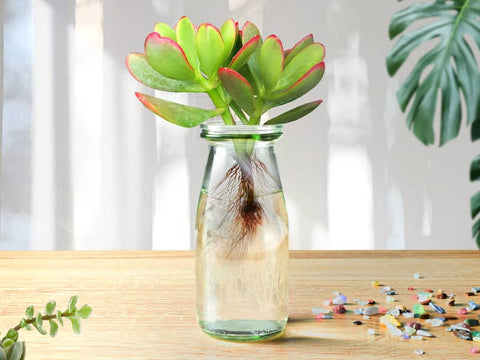Succulents are classic plants that are currently very trendy. This close relative of the cacti family is easy to care for and comes in a wide variety of interesting shapes and sizes. Succulents can also be grown in water and are ideal for people who might be a little forgetful about tending to their houseplants.
Why Grow Succulents In Water?
Let growing succulent be easier and funnier: The cultivation of succulents can be a daunting task, particularly for novices, who may struggle with the precise balance of watering. Growing succulents in water is an effective solution. This approach can save a considerable amount of time, as it circumvents the need for frequent watering. Furthermore, it is a low-maintenance method that guarantees the survival of the succulents for extended periods, even in the absence of regular human intervention, such as during lengthy business trips or vacations.
Hydroponic succulents have higher ornamental value: Placing succulents in a transparent container for hydroponics allows individuals to view the stems, leaves, and flowers of the plant and observe the root stretch freely in clear water. Like a fish terrarium, this enhances the overall decorative appeal of the succulent.

Less risk of disease and pests: Growing succulents in water are relatively neater and cleaner, and the soilless growth environment reduces the risk of succulents being infested by insect pests. Even if a pest problem occurs, the visualization of hydroponics can help you find and solve the problem as soon as possible.
What Types Of Succulents Grow In Water?
Echeveria is a popular rose-shaped succulent that comes in several leaf colors. If you want to learn how to grow succulents in water, this is the one to start with.
Jade plants have thick, woody stems and oval-shaped leaves. This succulent develops a miniature tree-like appearance that makes them very appealing to grow as a decorative houseplant.
String Of Pearls is a cascading succulent that develops strands of green pearl-like globes. It’s ideal for growing in a tall glass container of water that will allow the 3-feet long stems covered with round pearl-like leaves to hang down.
String Of Nickles succulent has bluish-green flat leaves that develop on 3-feet long stems. The stems cascade downward to create the strings. This succulent will also produce white blooms.
String Of Bananas is a fast-growing succulent plant that develops green leaves that are shaped like bananas. The stems cascade downward and reach a mature length of 3-feet and will be covered with ‘banana’ leaves.
How To Care For Succulents When We Grow Them In Water
When you grow live succulents in water, you can neglect them for a few days, and the plants will continue to thrive. This is a great way to have a wide variety of houseplants that require minimal care, so you don’t have to worry about them.
Always use distilled water. The chlorine in tap water will kill succulents.
Do not place the containers in a full-sun location. The sun will heat the water and essentially cook the succulents.
How to care for echeveria in water - Keep the water level below the end of the stem. Only allow the roots to be submerged. Never get the leaves of the echeveria wet when adding water to the container.
How to care jade plant in water - Place the succulent cutting in the center of the glass container and suspend it so the tip of the cut end will touch the water. Keep it like this throughout its’ lifespan. Replenish water as needed but keep succulent leaves dry.

How to care for string succulents in water - Place the propagated string succulent near the outer edge of the container and suspend the cut end just above the water. This will allow the ‘strings’ to cascade over the edge and grow downward on the outside of the container.
Don’t try to transplant a succulent that has been growing in water into the soil. The root system developed by the plant is very different, and it probably will not survive in soil. However, there is still a scientific method to repot these water-rooted succulents in soil based. Click here to learn the full guide.
Succulent Propagation in Water
Cut off a healthy stem from the plant and placing it inside a plastic sandwich bag for five days. Keep the cutting out of direct sunlight and put it in a cool location. This will allow the cut end to form a scar so the plant won’t take up too much water when it’s being grown in a container of water.
After the cut end has scarred, take a sharp knife and cut half of the scar off. Make the cut diagonally. Place it in a container of water with the end barely above the water (some succulents grow better with the end in the water. ) Use chopsticks, plastic wrap, lengths of drinking straws, or something similar to keep the cutting suspended in the air just above the water. This will encourage the succulent cutting to develop roots that will grow down into the water.
It will take several weeks for the cuttings to develop a root system. Be patient. As long as the stem and leaves look healthy (not black or soft) the succulent cutting is doing exactly what it’s supposed to.
You may wonder: How to Propagate Succulents from Cuttings.


























4 thoughts on “How To Grow Succulents In Water”
Sandra
Great information for a beginner
Kim
If your succulents have been in soil, what is the method to switch them to water. Is it basically, cut the bottom and let it scar?
johan
Awesome post! Thanks for sharing the knowledge and keep up the good work.
Mark Duke
Yes, very interested in the opportunity to learn more about growing succulent plants with little sunshine
For indoor foruor office entrance
Sincerely mark Duke
1200 Royalty ave Odessa tx 79761
432 3079723